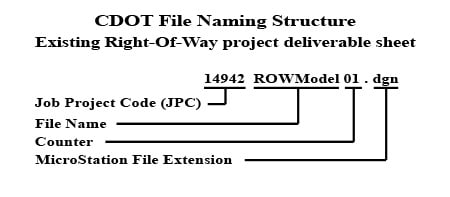
The project design workflow requires that, graphic data be created in multiple design files depending on discipline. Over the course of a CDOT project, many of the specialty groups will create graphical data in separate design files are referenced together to create the final product. These design files need standard, informative, and unique names allowing the CADD user to easily identify the specialty group responsible for the file and type of information contained within the final product.
All CDOT CADD drawings created should follow the standard naming convention so data can be easily identified and shared by all users. This standard allows CDOT users to work efficiently across projects while also allowing reviewers to easily find their desired files. A standardized file naming convention also enables efficient archiving and retrieval of project data.
The CDOT file naming convention contains the Job Project Code (JPC), file name, file counter, and file extension. Figure 1 shows a sample of an existing right-of-way file (reference file) created by Survey that is placed in the //14942/ROW_Survey/Drawings/Reference_Files/ folder for reference by other groups. The first segment of the CADD file name consists of five numbers that identify the project (JPC), the second segment defines the specific file with a simple description, and the third segment is a counter enabling multiple files of the same name. Note: a fourth segment, the initials of the designer or engineer, is used on Working Files.

Along with the file naming convention addressed above, files are stored in a specific directory structure outlined in Chapter 3. Combining the file naming convention with the standardized directory structure allows users to efficiently find any necessary file.
Following the CDOT file naming convention and directory structure is imperative for team member cohesion, file location, and design information. This standard allows users to work on many different projects with minimal disruption.
CDOT uses three different types of files throughout a project. These include Model files, Sheet files, and Working files. While these files are all MicroStation CADD files, they are created for very different functions. These file types and their intended uses are outlined below:
Sheet files generally contain either references to model files or non-design related items such as general notes, special symbols, quantities, sheet borders, etc. Plan sets are made up of several sheet files, for example: //14942/Design/Drawings/14942IndexOfSheets01.dgn
Reference files are considered the most up-to-date model files and are available to other groups for reference. They should have the most current, non-sketch, or working information in them. For example: //14942/Design/Drawings/Reference_Files/14942DesignModel01.dgn
Working files are necessary because MicroStation’s dynamic updating may impact other users that have a file attached as a reference file. To eliminate confusion between users, a Working file (or Working Model) should be used during the design phase. The working file is a duplicate of the master Model file found in the Specialty Group /Drawings/Reference_Files folder and is stored in the Specialty Group /Working folder.
The file naming convention for a working file is the standard model file name with the designer’s initials prefixing the model name. For example, John Q. Smith’s working file copy of “12345DesignModel01.dgn” would be named
“JQS12345DesignModel01.dgn”. This makes sorting and file recognition easier.
When the Designer is ready to share information with other groups, the file should be copied into the Specialty Group /Drawings/Reference_Files folder. Only files in the Reference_Files folder should be used as reference files. Working files should never be attached to Project Plan Sheets. The Designer"s initials must be removed from the file name when it is moved to the Reference_Files folder.
Detail files are model files containing graphical detail information (i.e. bridge details) that serve as reference files.
These files represent all the sheet files that do not fall into the other four categories (i.e. border sheets).